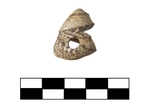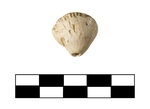Document Content
Bone Summary
T-86 Bone Summary
|
Locus |
Total # of bone fragments |
Percentage of bone fragments |
|
1 |
15 |
4% |
|
2 |
19 |
5% |
|
3 |
3 |
1% |
|
4 |
58 |
14% |
|
5 |
9 |
2% |
|
6 |
25 |
6% |
|
7 |
36 |
9% |
|
8 |
30 |
8% |
|
9 |
0 |
0% |
|
10 |
2 |
0% |
|
11 |
12 |
3% |
|
12 |
0 |
0% |
|
13 |
32 |
8% |
|
14 |
43 |
11% |
|
15 |
90 |
22% |
|
16 |
15 |
4% |
|
Baulk Trim |
12 |
3% |
|
Total |
401 |
|
Relatively large quantities of bone were found in T-86; we were working in only a small area of the trench and each locus was small in size.
In Loci 1 and 2 , situated above the capped cutting through fill deposits and galestra ( Loci 3 , 5 - 9 ), bone was evenly distributed but relatively scarce compared to underlying strata. Locus 3 , the stone capping of stones, contained very little bone, but this is to be expected, given the nature of the locus. Throughout most of the loci of the circular cut ( Loci 6 - 8 ), bone was fairly common and evenly distributed; it was less prevalent in Locus 5 , the deposit in the circular cut immediately underlying the stone capping.
In Loci 4 , 13 - 16 , the deposits surrounding the circular cut and capping, we recovered high quantities of bone. Notably, these quantities are higher than those from within the circular cutting. The three loci with the highest quantities of bone were Loci 4 , 14 , and 15 . Loci 4 and 15 are equivalent both are the uppermost deposits through which the circular cutting was cut and so this is not surprising. Overall, 36% of all bone recovered from T-86 was found in these two loci. Locus 14 , which underlay Locus 13 and was directly atop galestra, contained high quantities of bone as well. This in is contrast to the locus to which Locus 14 is equivalent, Locus 16 ; only small quantities of bone were found in Locus 16 . Also surprising is that even though Loci 13 and 15 are equivalent, as
both were the uppermost deposits through which the circular cutting was cut, Locus 13 contained relatively less bone than Locus 15 .
The only loci not to contain any bone were Loci 9 and 12 , both of which were galestra.
Most of the bone recovered from T-86 was not worked, although we did find numerous examples of burnt bone and some of cut bone. Additionally, we recovered one bone that was clearly cut, two fragments of antler ( 20160013 ), one bone bead ( 20160082 ), and two shells with bore holes that may have been worn as pendants ( 20160024 & 20160072 ).
In addition to the examples of worked bone, we also special found all pieces of diagnostic bone recovered within the trench.
| Descriptive Attribute | Value(s) |
|---|---|
| Document Type | Trench Book Entry |
| Trench Book Entry Date | 2016-08-04 |
| Entry Year | 2016 |
| Start Page | 273 |
| End Page | 276 |
| Title | Bone Summary |
| Descriptive Attribute | Value(s) |
|---|---|
|
Is Part Of
Vocabulary: DCMI Metadata Terms (Dublin Core Terms) |
KRK X
Vocabulary: Murlo |
Suggested Citation
Katharine R. Kreindler. (2017) "KRK X (2016-08-04):273-276; Bone Summary from Europe/Italy/Poggio Civitate/Tesoro/Tesoro 86/2016, ID:713". In Murlo. Anthony Tuck (Ed). Released: 2017-10-04. Open Context. <https://opencontext.org/documents/82d8bbf8-db4d-4bed-9897-b2a636ccb985> ARK (Archive): https://n2t.net/ark:/28722/k2b56vh37
Copyright License
To the extent to which copyright applies, this content
carries the above license. Follow the link to understand specific permissions
and requirements.
Required Attribution: Citation and reference of URIs (hyperlinks)











